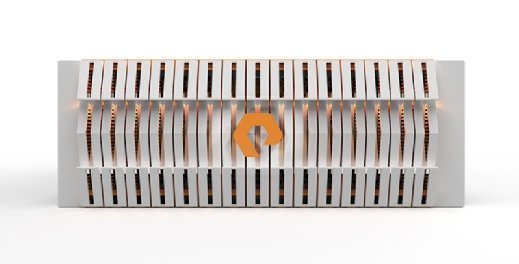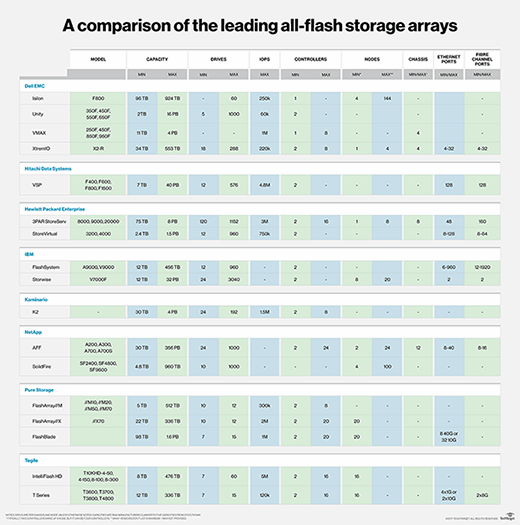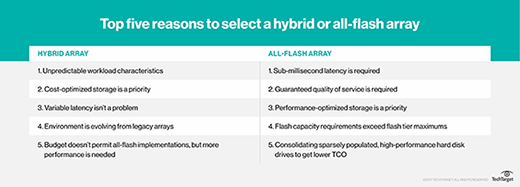all-flash array (AFA)
What is an all-flash array?
An all-flash array (AFA), also known as a solid-state storage disk system or a solid-state array, is an external storage array that uses only flash media for persistent storage. Flash memory is used in place of the spinning hard disk drives (HDDs) that have long been associated with networked storage systems.
Vendors that sell all-flash arrays usually allow customers to mix flash and disk drives in the same chassis, a configuration known as a hybrid array. However, those products often represent the vendor's attempt to retrofit an existing disk array by replacing some of the media with flash.
All-flash array design: Retrofit or purpose-built
Other vendors sell purpose-built systems designed natively from the ground up to only support flash. These models also embed a broad range of software-defined storage features to manage data on the array.
A defining characteristic of an AFA is the inclusion of native software services that enable users to perform data management and data protection directly on the array hardware. This is different from server-side flash installed on a standard x86 server. Inserting flash storage into a server is much cheaper than buying an all-flash array, but it also requires the purchase and installation of third-party management software to supply the needed data services.
This article is part of
Flash memory guide to architecture, types and products
Leading all-flash vendors have written algorithms for array-based services for data management, including clones, compression and deduplication -- either an inline or post-process operation -- snapshots, replication and thin provisioning.
As with its disk-based counterpart, an all-flash array provides shared storage in a storage area network or network-attached storage environment.
How an all-flash array differs from disk
Flash memory, which has no moving parts, is a type of nonvolatile memory (NVM) that can be erased and reprogrammed in units of memory called blocks. It is a variation of erasable programmable read-only memory (EEPROM), which got its name because the memory blocks can be erased with a single action, or flash. A flash array can transfer data to and from solid-state drives (SSDs) much faster than electromechanical disk drives.
The advantage of an all-flash array, relative to disk-based storage, is full bandwidth performance and lower latency when business applications make a query to read the data. The flash memory in an AFA typically comes in the form of SSDs, which are similar in design to an integrated circuit.

Flash is more expensive than spinning disk, but the development of multi-level cell (MLC) flash, triple-level cell (TLC), NAND flash and 3D NAND flash has lowered the cost of ownership. These technologies enable greater flash density without the cost involved in shrinking NAND cells.
MLC flash is slower and less durable than single-level cell (SLC) flash, but companies have developed software that improves its wear level to make MLC acceptable for enterprise applications. SLC flash remains the choice for applications with the highest input/output requirements and is also widely used by public cloud providers. However, TLC flash reduces the price more than MLC; although, it also comes with performance and durability tradeoffs that can be mitigated with software.
All-flash array vs. hybrid array
All-flash arrays are storage arrays containing only flash disks, whereas hybrid arrays contain a mixture of flash disks (SSDs) and traditional HDDs. The HDDs are commonly referred to as the capacity tier, whereas the SSDs are often called the performance tier.
There are two ways that hybrid arrays are commonly used. The first option is for a storage admin to simply create a virtual disk on top of either the performance pool or the capacity pool. This gives the admin the flexibility to choose the type of storage and effective capacity that is most suitable for the workload. This can be especially useful in hybrid cloud environments because hybrid clouds often host a mixture of workloads with varying storage requirements.
The other option is to use the performance tier as a cache. Hot data -- data that has recently been created or accessed -- is automatically moved to the performance tier, so anyone accessing that data will experience SSD-level performance. As the data cools off -- is accessed less frequently -- the cool data is automatically moved to the capacity tier to make room in the performance tier for new data. The advantage to using this approach is that it provides a way for organizations to reach a level of storage performance that is somewhat comparable to that of an all flash array but at a significantly lower cost. Additionally, hybrid arrays enable organizations to achieve a higher overall storage capacity than what might be possible with an all flash array.
Considerations for buying an all-flash array
Deciding to buy an AFA involves more than simple comparisons of vendor products. There are a number of factors that must be considered prior to purchasing an AFA, including:
- Application performance. An all-flash array that delivers massive performance increases to a specific set of applications may not provide equivalent benefits to other workloads. For example, running virtualized applications in flash with inline data deduplication and compression tends to be more cost-effective than flash that supports streaming media in which unique files are uncompressible.
- Read performance. An all-SSD systemwill produce smaller variations than that of an HDD array in maximum, minimum and average latencies. This makes flash a good fit for most read-intensive applications.
- Write performance. Write-intensive workloads require a special algorithm to collect all the writes on the same block of the SSD, thus, ensuring the software always writes multiple changes to the same block.
- Endurance. Garbage collectioncan present a similar issue with SSDs. A flash cell can only withstand a limited number of writes, so wear leveling can be used to increase flash endurance. Most vendors design their all-flash systems to minimize the impact of garbage collection and wear leveling; although, users with write-intensive workloads may wish to independently test a vendor's array to determine the best configuration.
- Cost. Despite paying a higher upfront price for the system, users who buy an AFA may see the cost of storage decline over time. This is tied to an all-flash array's increased CPU utilization, which means an organization will need to buy fewer application servers.
- Data center impact. The physical size of an AFA is smaller than that of a disk array, which lowers the rack count. Having fewer racks in a system also reduces the heat generated and the cooling power consumed in the data center.
All-flash array vendors, products and markets
Flash was first introduced as a handful of SSDs in otherwise all-HDD systems with the purpose to create a small flash tier to accelerate a few critical applications. Thus, the hybrid flash array was born.
The next phase of evolution arrived with the advent of software that enabled an SSD to serve as a front-end cache for disk storage, extending the benefit of faster performance across all the applications running on the array.
The now-defunct vendor Fusion-io was an early pioneer of fast flash. Launched in 2005, Fusion-io sold Peripheral Component Interface Express (PCIe) cards packed with flash chips. Inserting the PCIe flash cards in server slots enabled a data center to boost the performance of traditional server hardware. Fusion-io was acquired by SanDisk in 2014, which itself was subsequently acquired by Western Digital Corp. in 2016.
Also breaking ground early was Violin, whose systems -- designed with custom-built silicon -- gained customers quickly, fueling its rise in public markets in 2013. By 2017, Violin was surpassed by all-flash competitors whose arrays integrated sophisticated software data services. After filing for bankruptcy, the vendor was relaunched by private investors as Violin Systems in 2018, with a focus on selling all-flash storage to managed service providers.

All-flash array vendors, such as Pure Storage and XtremIO -- part of Dell EMC -- were among the earliest to incorporate inline compression and data deduplication, which most other vendors now include as a standard feature. Adding deduplication helped give AFAs the opportunity for price parity with storage based on cheaper rotating media.
A sampling of leading all-flash array products includes the following:
- Dell EMC SC
- Dell EMC PowerStore
- Dell EMC PowerVault
- Fujitsu Eternus
- Hewlett Packard Enterprise (HPE) Alletra
- Hitachi Vantara Virtual Storage Platform
- Huawei OceanStor
- IBM FlashSystem
- NetApp All-Flash FAS
- NetApp SolidFire family -- including NetApp HCI (hyper-converged infrastructure)
- Pure Storage FlashArray
- Pure FlashBlade
- Tintri N-Series
- Tintri H-Series
Impact on hybrid arrays use cases
Falling flash prices, data growth and integrated data services have increased the appeal of all-flash arrays for many enterprises. This has led to industry speculation that all-flash storage can supplant hybrid arrays; although, there remain good reasons to consider using a hybrid storage infrastructure.
HDDs offer predictable performance at a fairly low cost per gigabyte; although, they use more power and are slower than flash, resulting in a high cost per input/output per second (IOPS). All-flash arrays also have a lower cost per IOPS, coupled with the advantages of speed and lower power consumption, but they carry a higher upfront acquisition price and per-gigabyte cost.

A hybrid flash array enables enterprises to strike a balance between relatively low cost and balanced performance. Since a hybrid array supports high-capacity disk drives, it offers greater total storage than an AFA.
All-flash NVMe and NVMe over fabrics
All-flash arrays based on nonvolatile memory express (NVMe) flash technologies represent the next phase of maturation. The NVMe host controller interface speeds data transfer by enabling an application to communicate directly with back-end storage.
NVMe is meant to be a faster alternative to the Small Computer System Interface standard that transfers data between a host and a target device. Development of the NVMe standard is under the auspices of NVM Express Inc., a nonprofit organization comprising more than 100-member technology companies.
The NVMe standard is widely considered to be the eventual successor to the Serial-Attached SCSI and Serial Advanced Technology Attachment protocols. NVMe form factors include add-in cards, U.2 2.5-inch and M.2 SSD devices.
Some of the NVMe-based products available include:
- HPE Alletra 9000 4-way NVMe Storage Base
- SuperMicro SuperStorage Systems
- Pure Storage FlashArray//X
- Tintri NVMe Flash N-Series
A handful of NVMe-flash startups are bringing products to market, as well, including:
- Excelero. Software-defined storage runs on any x86 server.
- Exten. Offers an open standard based NVMe over fabrics (NVMe-oF) platform.
- Pavilion Data Systems. Builds hyper parallel flash arrays.
Presently, storage vendors seem focused on creating flash storage systems based on NVMe-oF. These systems integrate custom NVMe flash modules as a fabric in place of a bunch of NVMe SSDs.
The NVMe-oF transport mechanism enables a long-distance connection between host devices and NVMe storage devices.
All-flash storage arrays in hyper-converged infrastructure
HCI systems combine computing, networking, storage and virtualization resources as an integrated appliance. Most hyper-convergence products are designed to use disk as front-end storage, relying on a moderate flash cache layer to accelerate applications or to use as cold storage.
However, all-flash HCI nodes are widely available.







